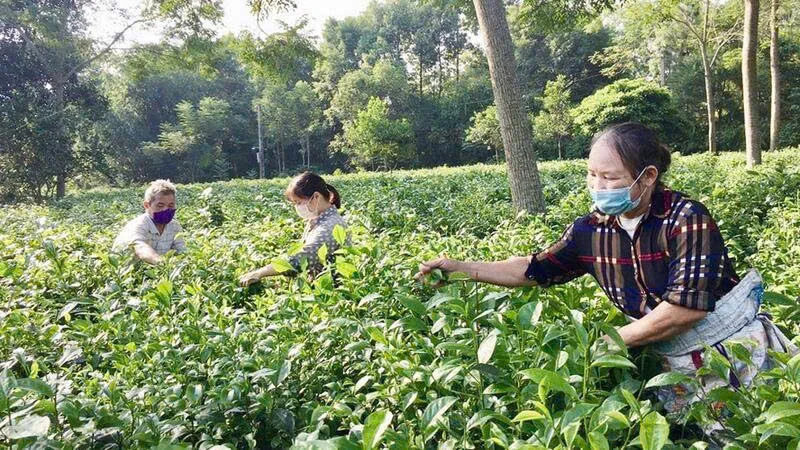Along with improving product quality, the combination of developing agricultural tourism is expected to contribute to enhancing the value of Ba Trai tea trees.
Ba Trai tea is famous for its characteristic aroma and strong tea flavour. When brewed it has a golden green colour; when drank it has an astringent and sweet aftertaste.
Actively applying high technology in production
Ba Trai is the largest tea growing area in Ba Vi District with an area of about 600 hectares. Ba Trai's tea output reaches more than 5,000 tonnes per year, accounting for nearly 50% of the total tea output of the whole district. The commune has ten villages, nine of which are recognised as traditional dry bud tea processing villages.
Almost every household in Ba Trai grows tea, with each household having an average of 2,000-3,000 square metres of tea. Tea trees account for 60% of the local agricultural economic structure.
Each year, Ba Trai tea trees yield seven to eight harvests. The main tea season lasts from April to September, each hectare yields 8-10 tonnes of fresh bud tea. Currently, Ba Trai dry bud teas are sold at prices ranging from 300,000-500,000 VND per kg, generating an income of about 300 million VND per ha each year.
Duong Van Huyen, Director of Ba Trai Agricultural and General Service Cooperative, said that in recent years, thanks to the application of science and technology in production, the quality of Ba Trai tea has improved significantly.
Over the past 10 years, tea growers in Ba Trai have invested in automatic tea roasting machines, and the tea rolling process also uses machines, so the tea quality has been improved, ensuring food hygiene and safety.
There have also been many changes in watering tea, many families have invested in automatic watering systems.
High-quality tea varieties have also been promoted for production, thanks to which 70% of the tea area in Ba Trai is high-quality tea varieties.
Over the past 10 years, tea growers in Ba Trai have invested in automatic tea roasting machines, and the tea rolling process also uses machines, so the quality of tea has been improved, ensuring food hygiene and safety. High-quality tea varieties are also being promoted for production, thanks to which 70% of the tea area in Ba Trai is producing high-quality tea varieties.
Duong Van Huyen,
Director of Ba Trai Agricultural and General Service Cooperative
In Ba Trai, there are currently many households growing tea according to the VietGAP model, applying scientific and technical advances in caring for and producing tea in a safe direction, especially in villages 2 and 3.
In the process of caring for the trees, people take advantage of agricultural by-products to make organic fertilisers for the trees, limiting the use of chemical fertilisers. When the tea trees are sick, people prioritise using biological products and biological pesticides to treat the disease.
The quality of tea in Ba Trai is constantly improving. In 2019, Ba Trai Commune built and affirmed the collective brand "Ba Trai Dried Bud Tea", thanks to which it has achieved having a certain position in the tea market.
According to Hanoi Coordination Office of the New-Style Rural Development Programme, in 2021, Ba Trai Dried Bud Tea was recognised as a 3-star OCOP product by the Hanoi People's Committee. This contributes to increasing product value, linking production development with tourism types, opening a new direction for Ba Trai tea.
Exploiting tourism potential
Ba Trai Commune is located about 16km from the centre of Ba Vi District, with convenient transportation. Ba Trai has great advantages for tourism development. Along with tea hills stretching across the hillsides and mountains, Ba Trai is also blessed with beautiful natural scenery and a cool, fresh climate. This land still preserves many diverse customs and practices.
Ba Trai was quick to meet the criteria for advanced of new-style rural areas. The traffic system and infrastructure have been invested in a systematic and synchronous manner.
In recent times, Ba Trai Commune has mobilised people to renovate tea gardens, creating beautiful landscapes to attract tourists to visit.
Duong Van Huyen, Director of Ba Trai Agricultural and General Service Cooperative, said that many groups of tourists have come to visit Ba Trai.
When coming to Ba Trai, tourists have the opportunity to admire the beautiful natural landscape, learn about and experience the process of cultivating tea trees from caring for the trees to harvesting to roasting and rolling the tea, and can enjoy a hot pot of tea with the typical flavour of Ba Trai’s mountains and forests.
Despite the great tourism potential, tourism development in Ba Trai is still spontaneous. Mainly by some local households and those from other places who come to do tourism in the form of homestays. In general, tourism development in Ba Trai is still fragmented, lacking cohesion, and lacking proper planning and strategy.
To enhance product value, link production development with tourism types, along with encouraging people to grow and process safe tea, creating a closed production chain that both ensures tea quality and is convenient for tourists to visit, Ba Vi District needs to plan a tourism development project in Ba Trai, promote support for Ba Trai Commune to build an experiential tourism model to create highlights.
It is necessary to develop a variety of services and open training courses to help people better understand the importance and benefits of developing community tourism.
At the same time, it is necessary to disseminate knowledge and expertise about tourism, especially community tourism and agricultural tourism, as well as to equip people with skills in communication, reception and service for tourists in order to gradually build a professional, safe and friendly tourism culture.
















